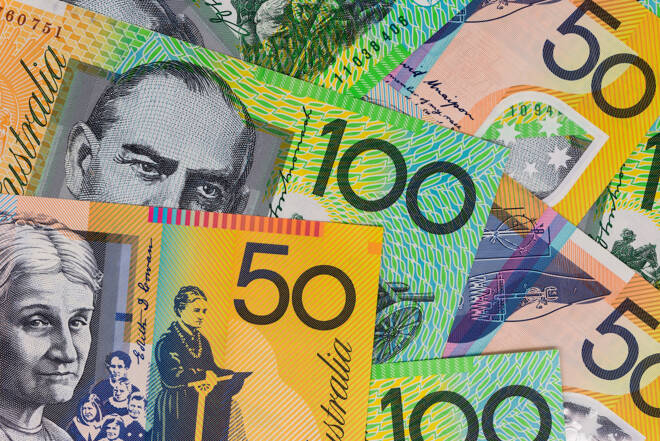Advertisement
Advertisement
AUD to USD Forecast: Balancing RBA Hike Prospects and Fed Rate Cut Signals
By:
Key Points:
- The AUD/USD slid by 0.61% on Thursday, ending the session at $0.65808.
- On Friday, Australian consumer inflation expectations and house price trends from China need consideration.
- Later in the session, US consumer sentiment and inflation expectation figures also warrant investor attention.
Thursday Overview of the AUD/USD
The AUD/USD slid by 0.61% on Thursday. Reversing a 0.23% gain from Wednesday, the Australian dollar ended the session at $0.65808. The Australian dollar rose to a high of $0.66318 before falling to a low of $0.65694.
Consumer Inflation Expectations and China in Focus
On Friday, Australian consumer inflation expectation numbers will garner investor interest. Economists forecast consumer inflation expectations to decline from 4.5% to 4.4% in March.
Hotter-than-expected inflation expectation numbers could influence bets on an RBA rate hike. In the February RBA Press Conference, Michele Bullock left a rate hike on the table. The RBA Governor also had this to say about current inflation levels,
“We want to see inflation continue to decline, and that’s more important than market pricing. Inflation has a four in front of it, which is too high.”
Investors must also consider house price trends from China and PBoC action. A more marked fall in house prices could impact iron ore prices, riskier assets, and the Aussie dollar. Economists forecast house prices to fall by 0.3% year-on-year in February after declining by 0.7% in January.
However, the PBoC could limit the impact of weak house price figures on the Aussie dollar. The PBoC will announce the one-year MLF rate. Economists expect the PBoC to cut the MLF rate from 4.5% to 4.4%. A larger-than-expected cut could boost demand for riskier assets and the Aussie dollar.
Economic data from China and PBoC stimulus measures are significant for the Australian economy and the Aussie dollar.
China accounts for one-third of Australian exports. Australia has a trade-to-GDP ratio of over 50%, with 20% of the Australian workforce in trade-related jobs.
Policy measures to bolster the Chinese economy could boost demand and improve trade terms with Australia. Significantly, measures to support the Chinese real estate sector could influence iron ore prices and buyer appetite for the Aussie dollar.
US Economic Calendar: Michigan Consumer Sentiment in Focus
On Friday, US consumer sentiment figures for March warrant investor attention. Economists forecast the Michigan Consumer Sentiment Index to remain steady at 76.9. An unexpected rise in the Consumer Sentiment Index could sink bets on an H1 2024 Fed rate cut.
A pickup in consumer sentiment could signal an upward trend in consumer spending, fueling demand-driven inflation. The Fed could delay the timing of an interest rate cut to reduce disposable income and curb consumer spending.
However, investors must also consider the sub-components. Consumer inflation expectations could also move dial.
Other stats include NY Empire State Manufacturing and US industrial production numbers. However, barring a slump in production, the consumer sentiment figures will likely have more influence.
Short-Term Forecast
Near-term AUD/USD trends will hinge on US consumer sentiment and stimulus measures from China. Better-than-expected numbers from the US could impact buyer demand for the AUD/USD. However, policy measures to bolster the Chinese economy could influence the RBA rate path. The RBA left a rate hike on the table in February while the Fed plans to cut interest rates.
AUD/USD Price Action
Daily Chart
The AUD/USD hovered below the 200-day EMA while remaining above the 50-day EMA. The EMAs sent bullish near-term but bearish longer-term price signals.
An Aussie dollar break above the 200-day EMA would support a move toward the $0.67003 resistance level.
Australian inflation expectations, stimulus measures from Beijing, and US consumer sentiment need consideration.
Conversely, an AUD/USD drop below the $0.65760 support level and the 50-day EMA would bring the $0.65500 handle into play. Buying pressure could intensify at the $0.65760 support level. The 50-day EMA is confluent with the support level.
Considering the RSI indicator, a 14-period Daily RSI reading of 52.30 indicates an AUD/USD move to the $0.67003 resistance level before entering overbought territory.
About the Author
Bob Masonauthor
With over 28 years of experience in the financial industry, Bob has worked with various global rating agencies and multinational banks. Currently he is covering currencies, commodities, alternative asset classes and global equities, focusing mostly on European and Asian markets.
Advertisement
